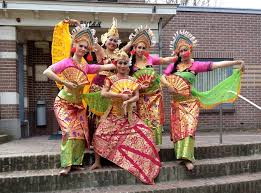The island of Java is one of the islands of the Indonesian archipelago. From 1945 it is part of the independent "Republic of Indonesia".
There are many different dance styles in Java. The main styles are the Pasundan or Sunda style, Javanese and Eastern Javanese style. From the fusion of indigenous ancient and pre- Indian cultures arose a Hindu - Javanese civilization.
In the current Javanese dance we find Hindu influences, such as the beautiful hand postures. In this Hindu - Javanese period there were mainly dance dramas with masks at the courts.
 Dances were designed by order of a prince with the intent to capture a particular event.
Dances were designed by order of a prince with the intent to capture a particular event.
In the 17th century, at the time of the principality Mataram belief was general Islamic (Moslem). Only then the dancing began to look as we know it now. Mataram splited into four principalities, who settled in Surakarta (Solo) and Yogyakarta (Yogya). Therefore there were now two different dance styles, Surakarta and Yogyakarta.
In classical Javanese dance, there are women and men dancing. One distinguishes in the men dance forms: Gagahan: lofty and powerful, and Halusan: noble and refined.
In Surakarta style go in the Gagahan the movements smoother and more fluent in each other than in the Yogyakarta style. That seems rather angular and broken. Also in the sophisticated men dance the Surakarta - style it is smoother. In the female dance is the sophisticated nature of both styles equally. The difference is in the movements, which are typically Surakarta or Yogyakarta style.
The classical Javanese dance borrows many stories to the Hindu period. They have roots in India. The dances pictures generally Ramayana or Mahabharata stories and characters that appear in legends and the history of Java.
In the early history of Java, there were already 'wayang' performances. The word is derived from 'bayangan’which means portrayal. "Wayan " is a visual depiction and veneration of ancestors. The 'wayang kulit' shadow is a performance in which the ancestors are portrayed with leather puppets. With a lamp, the shadows of the puppets are projected on a screen. The puppeteer or ‘dalang' tells the story.
Besides the religious dances and dance dramas there are dances, such as the ronggeng dance, a woman dance to entertain king and nobles. Outside the palace walls, this dance was called the 'tledek’.
